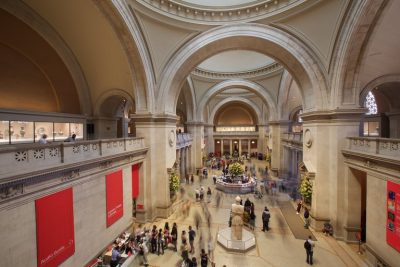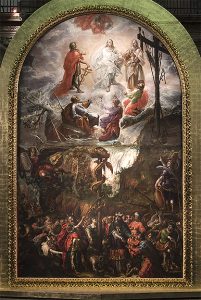Envisioning the Divine: Mexican Artist Villalpando at the New York Metropolitan Museum of Art

This month, the Robert Lehman Wing of New York’s Metropolitan Museum of Art is hosting the work of Mexican baroque artist, Cristóbal Villalpando (1649 –1714). The highlight of the show is Moses and the Brazen Serpent and the Transfiguration of Jesus (1683), a staggering 28-foot tall altarpiece that until now has never left its home in Puebla Cathedral.
Two distinct scenes are unfolding within a landscape that includes at once the wilderness of Exodus, and the Holy Mounts of Calvary and Tabor. It is of such scale and scope that one is swept away by the sheer grandeur of it.
The painter has arranged the scenes vertically and hierarchically – the bottom half concerns an episode from Chapter 21 in the Book of Numbers: when “the people spoke against God and against Moses,” questioning why they were brought out of Egypt “to die in the wilderness.” God immediately answers their impatience and ingratitude by sending “seraph serpents against the people” – deadly vipers that ‘consume man by the poison of their fangs.’ For Villalpando, these are a terrifying brood of winged monsters, suggested perhaps by the flying serpents mentioned in Isaiah (14:29).
Moses intercedes on behalf of the Israelites: he prays for the people to be forgiven and ‘one from whom forgiveness is asked… should not be so cruel as not to forgive’ (Rashi). God tells Moses to “make a seraph figure and mount it on a standard. If anyone who is bitten looks at it, he shall recover.” Moses fashions a serpent of brass and displays it as an ensign for the people.
Villalpando shows us Moses, luminescent horns beaming from his head, standing beside the pole around which is coiled a mighty winged serpent. The people gather round to gaze up towards it and be healed. Aaron, Moses’ brother, stands to the right of the pole wearing the elaborately embroidered garb of the high priest, ‘vested for beauty and for glory’, atop his head a horned mitre; at his feet are the wretched victims of God’s wrath, contorted bodies and bulging eyes.

Moses and the Brazen Serpent and the Transfiguration of Jesus (Source: The Met)
In the upper half we are presented with the Transfiguration of Jesus as described in the Synoptic Gospels: three apostles gaze up at the glorified body of Jesus, overwhelmed by his divine incandescence. Beside Christ are Moses and Elijah, presumably speaking of Jesus’ imminent crucifixion – reinforced by the imposing cross perched on the edge of a gloomy promontory, Calvary.
Villalpando brings together these two episodes, from the Old and New Testaments respectively, with a quote from the Gospel of John: “And as Moses lift up the serpent in the wilderness, even so must the son of man be lift up, that none that believeth in him perish” (3:14). The brazen serpent was not only a remedy for the wounded Israelites; it was later viewed as anticipating the Messiah, a sign of salvation.
Villalpando was not attempting simply to visually depict the brazen serpent – in a sense his aim was a far more ambitious one: to create or recreate as it were a brazen serpent, a work of art that is meant to heal the tortured, forsaken and forgotten. The brazen serpent healed the victims of the venomous snakes by their looking on it. Whatever power it had to heal was transmitted, in a sense, visually. This fact was obviously not lost on a painter as astute as Villalpando. Both the transfiguration and the brazen serpent ‘privilege vision as a means of comprehending the divine.’ His painting is among other things about the power of the artist to communicate the divine through painting.
Ten other works are part of the exhibit – including an extraordinary oil on copper depicting The Deluge (1689): not unlike Moses and the Brazen serpent, Noah’s building of the ark according to God’s instructions is, for Villalpando, a biblical precedent for artistic creation. The sky is streaked with lightening – scenes of mayhem and death crowd the picture’s foreground. The sight of rooftops peaking up above rising floodwaters cannot but resonate with us in the aftermath of storms like Hurricane Harvey that recently battered Texas.
The ark is presented as inaccessibly distant, but centrally fixed; its bronze hue is strikingly visible against the leaden sky and foamy sea. Size and pictorial distance do not seem to be realistically correlated in the Deluge: it is as if the painter has chosen to magnify certain scenes so as to emphasize and individualize the personal catastrophes that are unfolding amidst the general devastation.
The Brazen Serpent and Transfiguration is reason enough to make the pilgrimage to the Metropolitan Museum. Villalpando’s first true masterpiece is a visual feast: a massive tour de force. Indeed, the artist accomplished something extraordinary with this painting: a breathtaking and powerfully dramatic vision of pain and anguish, hope and healing; of redemption and transformation, a depiction of the victory of love and forgiveness over fear and despair, and a most welcome reprieve at this moment in time.
Sam Ben-Meir is a professor of philosophy and world religions at Mercy College in New York City.

